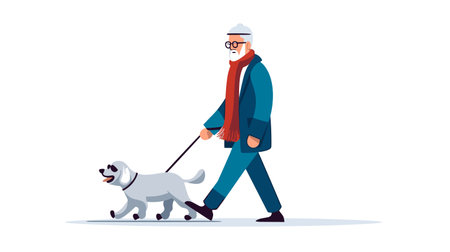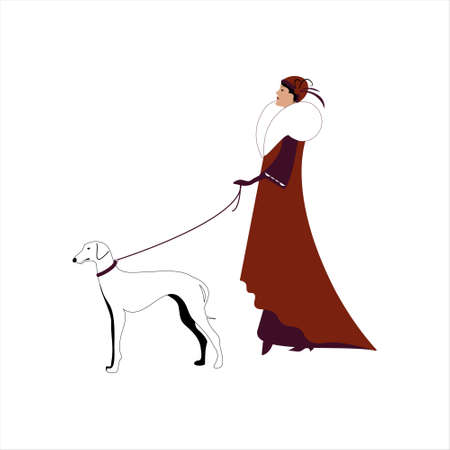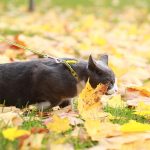Understanding the Aging Process in Dogs
Just like humans, dogs go through physical and behavioral changes as they age. Understanding these changes can help you provide the best care for your senior pup, ensuring they stay happy and healthy in their golden years.
Common Signs of Aging in Dogs
As your dog gets older, you may start noticing subtle or obvious signs of aging. Here are some common indicators that your dog is entering their senior years:
| Sign of Aging | Description |
|---|---|
| Gray Hair | You may notice graying fur, especially around the muzzle and face. |
| Reduced Energy Levels | Your dog may not be as active or playful as they once were. |
| Joint Stiffness | Aging dogs often develop arthritis or stiffness, making movement more difficult. |
| Changes in Appetite | Your dogs appetite may decrease, or they may become pickier with food. |
| Cognitive Changes | Your dog might seem confused, forget commands, or experience disrupted sleep patterns. |
| Hearing and Vision Loss | Sensory decline is common in older dogs, leading to difficulty seeing or responding to sounds. |
When to Start Making Lifestyle Adjustments
The right time to adjust your dogs lifestyle depends on their breed, size, and overall health. Generally, smaller dogs enter their senior years around 8-10 years old, while larger breeds age more quickly, often considered seniors by 5-7 years old. If you notice any of the signs listed above, its a good idea to start modifying their routine to support their changing needs.
Pacing Their Exercise Routine
Your senior dog still needs exercise but at a gentler pace. Shorter, more frequent walks can help maintain mobility without causing strain.
Nutritional Considerations
Aging dogs benefit from diets rich in joint-supporting nutrients like glucosamine and omega-3 fatty acids. Consult your vet about switching to a senior-friendly formula.
Mental Stimulation
Puzzle toys and interactive games can keep your senior dogs mind sharp and engaged.
The Importance of Regular Vet Checkups
Your veterinarian plays a key role in monitoring your dogs aging process. More frequent checkups (at least twice a year) can help catch age-related issues early and ensure your furry friend stays as comfortable as possible.
Nutrition and Diet for Senior Dogs
As your dog ages, their nutritional needs change. A well-balanced diet can help maintain their energy levels, support joint health, and keep their weight in check. Here’s how you can ensure your senior pup gets the best nutrition possible.
Choosing the Right Food for Your Senior Dog
Senior dogs benefit from diets that are rich in high-quality protein, fiber for digestion, and essential fatty acids to support brain and joint health. Look for dog food labeled specifically for senior dogs, as these formulas often contain the right balance of nutrients.
Key Nutrients for Aging Dogs
| Nutrient | Benefits | Sources |
|---|---|---|
| Protein | Maintains muscle mass and overall strength | Chicken, fish, turkey, lean beef |
| Omega-3 Fatty Acids | Supports joint health and cognitive function | Fish oil, flaxseed, salmon |
| Fiber | Aids digestion and prevents constipation | Pumpkin, sweet potatoes, brown rice |
| Glucosamine & Chondroitin | Helps with joint pain and mobility | Shellfish, green-lipped mussels, supplements |
| Antioxidants | Boosts immune system and reduces inflammation | Berries, spinach, carrots |
Managing Your Senior Dog’s Weight
Aging dogs tend to be less active, which makes weight management crucial. Excess weight can put strain on joints and increase the risk of conditions like arthritis or diabetes. Here are some tips to maintain a healthy weight:
- Measure Portions: Avoid overfeeding by following recommended portion sizes based on your dogs weight and activity level.
- Select Low-Calorie Treats: Opt for healthy treats like carrot sticks or blueberries instead of high-calorie biscuits.
- Create a Feeding Schedule: Stick to regular meal times instead of free-feeding to prevent overeating.
- Add Moisture to Meals: Wet food or adding warm water to kibble can make meals easier to chew and digest.
- Avoid Table Scraps: Human food can lead to weight gain and digestive issues—stick with dog-friendly snacks.
The Importance of Hydration
Seniors are more prone to dehydration, so always provide fresh water. Consider adding bone broth or wet food if your dog isn’t drinking enough. A pet fountain may also encourage them to drink more.
Treating Age-Related Dietary Issues
If your senior dog has specific health concerns like kidney disease or arthritis, consult your vet about specialized diets that can help manage their condition. Prescription diets or homemade meals tailored to their needs may be necessary.
A well-planned diet plays a vital role in helping your senior dog stay active, comfortable, and happy. By providing nutrient-rich foods and managing their weight effectively, you’re giving them the best chance at aging gracefully.

3. Exercise and Mobility Support
As dogs age, their energy levels may decrease, and joint issues like arthritis can make movement more challenging. However, regular exercise is still essential to maintain muscle strength, a healthy weight, and overall well-being. The key is finding the right balance between activity and joint protection.
Low-Impact Exercises for Senior Dogs
High-impact activities like jumping or long runs can be tough on aging joints. Instead, opt for gentler exercises that keep your senior dog moving without causing strain.
| Exercise | Benefits |
|---|---|
| Short Walks | Helps maintain mobility and prevents stiffness. |
| Swimming | Great for joint health as it reduces pressure while providing full-body exercise. |
| Puzzle Toys | Keeps them engaged mentally while promoting gentle movement. |
| Indoor Play | Encourages movement in a controlled environment with soft surfaces. |
Mobility Aids for Aging Dogs
If your senior dog struggles with movement, mobility aids can provide extra support and comfort.
- Orthopedic Beds: Provide cushioning for sore joints and improve sleep quality.
- Ramps & Stairs: Help dogs get on furniture or into cars without straining their joints.
- Harnesses with Lifting Support: Offer assistance for dogs who have trouble standing or walking.
- Non-Slip Rugs & Flooring: Prevent slipping accidents, making movement safer indoors.
How to Keep Your Senior Dog Active Safely
Every dog is different, so its important to tailor their exercise routine based on their needs. Here are some tips:
- Monitor Their Comfort: Watch for signs of fatigue or pain, such as limping or reluctance to move.
- Keep Sessions Short: Several short walks are better than one long session that may cause discomfort.
- Avoid Slippery Surfaces: Hard floors can be difficult for older dogs to navigate, increasing the risk of falls.
- Consult Your Vet: If youre unsure about an exercise routine, check with your veterinarian for personalized recommendations.
With the right balance of gentle exercise and supportive tools, you can help your senior dog stay active and comfortable throughout their golden years.
4. Preventative Health Care and Vet Visits
As your dog enters their senior years, proactive health care becomes more important than ever. Regular vet visits, vaccinations, dental care, and early detection of age-related diseases can significantly improve their quality of life.
Regular Check-Ups: A Must for Senior Dogs
Routine veterinary check-ups help detect potential health issues before they become serious. Most vets recommend senior dogs have a wellness exam every six months instead of just once a year.
What to Expect During a Senior Dog Check-Up
| Check-Up Component | Why It’s Important |
|---|---|
| Bloodwork | Helps detect early signs of kidney disease, liver problems, or diabetes. |
| X-rays or Ultrasound | Can reveal arthritis, tumors, or internal organ issues. |
| Weight Monitoring | A sudden weight gain or loss could indicate underlying health concerns. |
| Mental and Mobility Assessment | Aids in identifying cognitive decline or joint pain. |
The Importance of Vaccinations and Preventative Medications
Your senior dog may not require vaccinations as frequently as when they were younger, but staying up to date is still essential. Talk to your vet about core vaccines like rabies and distemper, as well as optional ones based on your dogs lifestyle.
Deworming and Parasite Prevention
Aging dogs have weaker immune systems, making them more vulnerable to parasites such as fleas, ticks, and heartworms. Keep up with regular preventative treatments to ensure their comfort and well-being.
Caring for Your Senior Dog’s Dental Health
Poor dental hygiene can lead to infections that affect major organs like the heart and kidneys. Routine cleanings and at-home dental care are crucial for maintaining oral health.
Tips for Maintaining Dental Health at Home
- Brush Their Teeth: Use a dog-safe toothpaste and brush regularly.
- Provide Dental Chews: These help reduce plaque buildup.
- SCHEDULE Professional Cleanings: Your vet may recommend annual cleanings.
The Benefits of Early Disease Detection
Catching health problems early increases the chances of successful treatment. Be aware of changes in appetite, behavior, mobility, or bathroom habits—these could be signs of underlying issues that need veterinary attention.
Aging Signs That Require a Vet Visit
- Lethargy or Reduced Activity Levels
- Persistent Coughing or Breathing Issues
- Dramatic Weight Changes (Gain or Loss)
- Trouble Standing Up or Walking
- Lumps or Unusual Growths on the Body
Your senior dog depends on you to keep them happy and healthy. By prioritizing preventative health care and regular vet visits, you can help ensure they enjoy their golden years comfortably.
5. Enhancing Quality of Life and Comfort
As dogs age, their needs change, and ensuring they remain comfortable and happy is essential. By making small adjustments to their living environment, managing pain effectively, and providing mental stimulation, you can help your senior dog enjoy their golden years.
Creating a Comfortable Living Environment
A senior dogs body becomes more sensitive to temperature changes, hard surfaces, and mobility challenges. Making modifications to your home can greatly improve their quality of life.
| Adjustment | Benefit |
|---|---|
| Orthopedic Bed | Provides extra cushioning for joints and relieves pressure points. |
| Non-Slip Rugs | Prevents slipping on hardwood or tile floors, reducing injury risk. |
| Elevated Food & Water Bowls | Eases strain on the neck and joints while eating and drinking. |
| Easier Access to Favorite Spots | Add ramps or steps to help them reach couches or beds without jumping. |
| Mild Temperature Control | Seniors are more sensitive to cold and heat; keep their environment comfortable. |
Pain Management Strategies
Aging often comes with joint stiffness, arthritis, or other chronic pain conditions. Managing pain properly can significantly improve your dog’s comfort.
- Veterinary Guidance: Regular check-ups can help monitor and adjust treatments as needed.
- Pain Medication & Supplements: Options like glucosamine, fish oil, or prescribed medications can ease discomfort.
- Mild Exercise: Gentle walks or hydrotherapy help maintain mobility without overexertion.
- Massage & Physical Therapy: Can relieve tension and promote circulation in aging muscles.
- A Warm Sleeping Area: Cold temperatures can worsen joint pain—keep their bed warm and cozy.
Mental Stimulation for a Happy Mind
Cognitive decline is common in senior dogs, but keeping their minds engaged helps prevent confusion and anxiety.
- Puzzle Toys: Interactive toys encourage problem-solving and keep them entertained.
- Nose Work Games: Hide treats around the house to stimulate their sense of smell and curiosity.
- Short Training Sessions: Teaching new tricks (even simple ones) keeps their brain active.
- Sensory Stimulation: Take them on short outings to experience new smells, sights, and sounds.
- A Calm Routine: Consistency reduces stress and makes them feel secure in their daily life.
The Importance of Companionship
Your presence is one of the most comforting things for your senior dog. Spend quality time with them through gentle play, cuddling, or simply sitting together. Your love and attention are just as important as any physical adjustment you make for their well-being.
Caring for a senior dog requires patience and understanding, but with the right approach, you can ensure they continue to live a happy, comfortable life filled with love.


